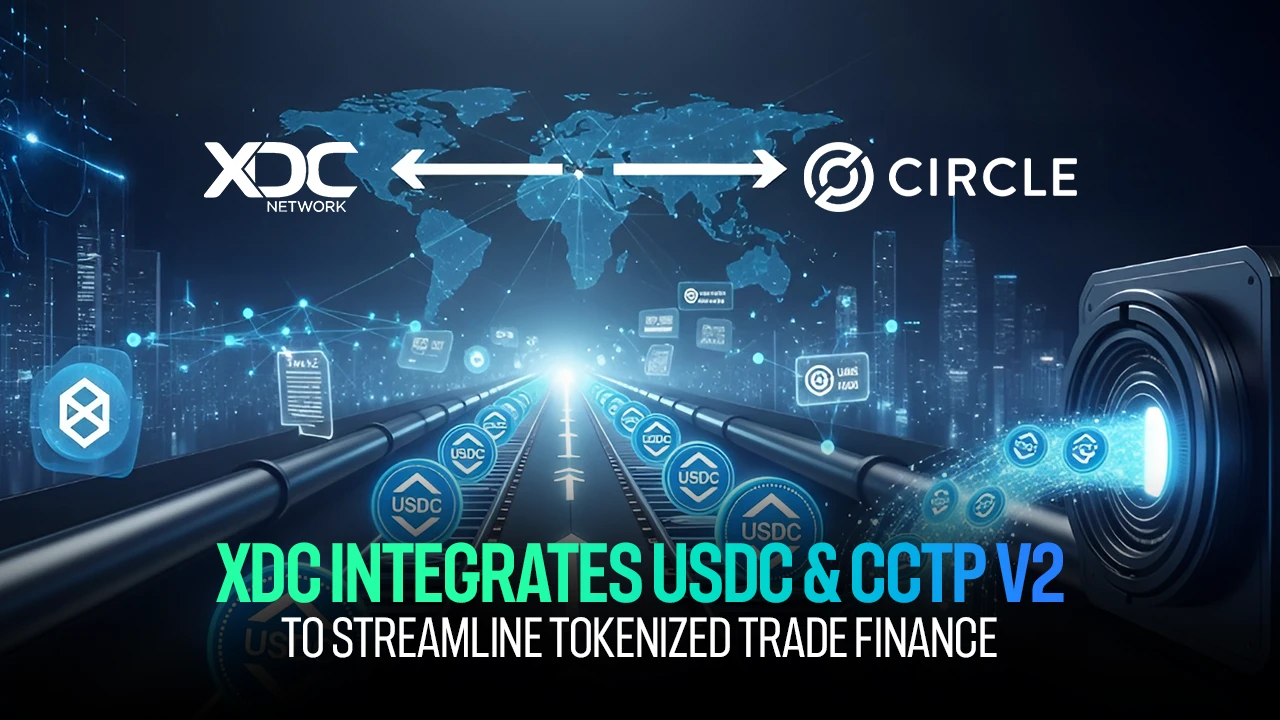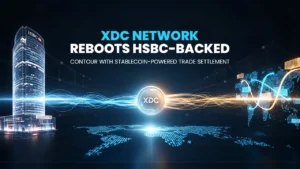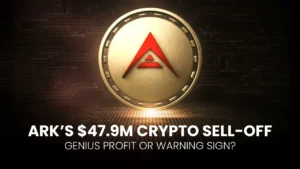Circle Deploys USDC and CCTP V2 on XDC Network to Simplify Cross-Border Payments

Circle has launched native USDC and Cross-Chain Transfer Protocol V2 on the XDC Network. The move places a regulated digital dollar on a chain built for trade finance and tokenized assets. CCTP’s burn-and-mint design keeps USDC canonical as funds move between chains, reducing operational risk for invoices, letters of credit, and private credit flows.
- Why Trade Finance Cares
- Cross-Chain Without Wraps
- RWA Pipeline and Where USDC Fits
- DPoS Finality: Key For Enterprise Settlement
- Adoption Watch: Custody, Treasury, Developers
- Regulatory and Audit Considerations
- Launch Snapshot
- Conclusion
- Frequently Asked Questions About USDC Launches On XDC
- How Is USDC On XDC Different From Bridged USDC?
- Does XDC’s DPoS Change Settlement Risk?
- What Should Treasurers Test First?
- Where Will Adoption Show Up First?
- What Are The Main Challenges?
- Glossary of Key Terms
XDC’s Delegated Proof of Stake targets low fees and deterministic finality, features that matter when cash events trigger legal steps. The question now is adoption, not plumbing. Custodians, tokenization venues, and treasury platforms will determine whether USDC on XDC becomes standard for subscriptions, coupons, and B2B payouts.
USDC & CCTP V2 are officially LIVE on XDC Network!
Developers, businesses, and institutions alike can now settle with the world’s largest regulated stablecoin directly on XDC.@Circle’s @USDC expands what’s possible across XDC:
✅ Trade finance
✅ RWA tokenization
✅… pic.twitter.com/bCb3UBkfyq— XDC Foundation (@XDCFoundation) September 17, 2025
Why Trade Finance Cares
Trade finance needs predictable settlement, clean audit trails, and cost control. Circle says USDC and CCTP V2 are live on XDC to support payments and real-world asset settlement without wrapped tokens that fragment liquidity.
XDC’s launch note points to enterprise-leaning tooling on an EVM stack that developers already understand. In practice, a factor can fund an invoice in USDC on XDC when documents clear, then move liquidity to another venue through CCTP without changing the token format.
Live contracts and developer docs indicate immediate pathways for integration, including contract addresses, Circle Mint flows, and CCTP endpoints. The operational pitch is simple.
One canonical USDC reduces exceptions, and deterministic finality lowers post-trade uncertainty. Those are the levers that shorten cycle times and compress working-capital costs, especially for receivables and milestone-based escrows. The next proof points are treasury dashboards that add XDC, custody listings, and RWA platforms that make USDC the default cash leg.
“USDC and CCTP V2 are now live on XDC Network,” Circle wrote, highlighting fast, low-cost payments, RWA tokenization, and cross-chain transfers.
Cross-Chain Without Wraps
CCTP V2 retires USDC on the origin chain and mints native USDC on the destination. The result is a single token representation and fewer back-office reconciliations.
Circle’s docs describe validation via its Attestation Service after hard finality, with a fast-transfer allowance that backs burns in flight. For auditors and risk teams, a one-to-one model avoids a web of bridge IOUs and basis risk. For treasurers, it means interchain rebalancing without switching tickers or tracking wrapped assets.
XDC’s coverage frames this as unified dollar liquidity for supply-chain finance and tokenized credit. A supplier can receive USDC on XDC after shipment confirmation, then the treasury can route those dollars to a different execution venue through CCTP for hedging or yield.
The path reduces contract sprawl and simplifies policy reviews for institutions that already custody USDC elsewhere. If adoption scales, CCTP will read less like a bridge and more like interchain settlement infrastructure embedded in enterprise workflows.
RWA Pipeline and Where USDC Fits
The launch lands on a chain with visible real-world asset plans. CoinDesk reported that Brazil’s VERT Capital aims to tokenize up to 1 billion dollars of debt and receivables on XDC over 30 months, spanning corporate credit and agribusiness instruments.
That scale implies recurring subscriptions and coupon flows where a regulated dollar is useful. In Asia, SBI XDC Network APAC and SS Trading outlined a program to record export documents on chain, conduct factoring during shipping, and automate collections.
The release describes “record[ing] trade documents on the blockchain” and “conduct[ing] factoring during the shipping period,” setting a template for routine transactions. If these deals standardize on USDC for inflows and outflows, settlement windows can tighten and FX slippage can fall when transactions cross borders.
The indicators to track are straightforward: issuance cadence, default use of USDC in cash legs, and custody connections that map on-chain positions to off-chain books without custom plumbing.
Record trade documents on the blockchain and conduct factoring during the shipping period, the SBI XDC APAC notice states, describing the initiative’s scope.
DPoS Finality: Key For Enterprise Settlement
Tokenized invoices behave differently from highly liquid tokens. Once a payment posts against a receivable, the record should be final and unambiguous. XDC’s consensus uses Delegated Proof of Stake with a HotStuff-style BFT committee.
XDC’s tech spec says XDC 2.0 brings confirmation as finalization, with transactions finalized about six seconds after inclusion, and documentation cites two-second block times. Deterministic finality reduces disputes and aligns on-chain events with off-chain legal steps. For banks and insurers, that clarity matters when title transfer and collateral releases depend on settlement.
Circle’s launch materials emphasize XDC’s low-cost, high-throughput profile, while XDC’s consensus notes highlight accountability and penalties for faults. The practical test is acceptance, not theory. If counterparties treat DPoS finality as settlement-final in normal conditions, the consensus model fades into the background and becomes plumbing for trade workflows, escrow triggers, and coupon postings.
Adoption Watch: Custody, Treasury, Developers
Institutional adoption tends to follow custody support and treasury workflow integration. Circle directs enterprises to Circle Mint for issuance and redemption, then to CCTP for interchain movement.
Early signals to track include custodians adding XDC to existing USDC coverage, treasury dashboards with XDC destinations, and developer repos referencing XDC contract addresses. XDC’s EVM compatibility reduces lift for teams porting factoring or supply-chain apps. For VERT’s Brazil program, a default USDC cash leg would show practical traction. For APAC pilots, routine export transactions that combine digitized documents with USDC payouts would demonstrate cycle-time gains. Potential challenges remain.
Regional regulatory reviews vary, some banks prefer private networks, and operational sign-offs can be slow. Even so, a regulated stablecoin plus deterministic finality lowers technical friction. If volumes appear quickly, USDC on XDC will move from pilot to production and set a template for invoice-level finance across markets.
Regulatory and Audit Considerations
Attested reserves and a single canonical token simplify reviews. Circle positions USDC as a regulated digital dollar with public reporting and chain-specific contracts. CCTP preserves that canonical status when funds move across chains through burn-and-mint, avoiding wrapped copies that complicate liabilities tracking. On the network side, XDC promotes energy-efficient DPoS, fast finality, and enterprise configuration options. For trade finance, where KYC, risk scoring, and documentary checks dominate, the key benefit is fewer exceptions and clearer sequencing from purchase order, to shipment, to payment.
SBI’s program points to a model case: documents recorded on chain, factoring while goods are in transit, and automated collection. Adoption still depends on institutional buy-in and custody coverage, but the stack reduces integration work that often stalls pilots. The combination of USDC’s attestation model and XDC’s deterministic settlement offers a policy-friendly path to standardize cash legs in tokenized credit.
ALSO READ: 67.9M ADA Worth $54.3M Exits Coinbase Into 4.19B Whale Wallet Without Delegation
Launch Snapshot
| Item | Detail | Source |
| Launch Date | USDC and CCTP V2 live on XDC, Sept 17, 2025 | Circle, XDC Foundation |
| Transfer Model | CCTP burn-and-mint, no wrapped tokens | Circle CCTP |
| RWA Pipeline | VERT to tokenize up to $1B in 30 months | CoinDesk |
| Trade Pilot | SBI XDC APAC export docs, factoring, automation | SBI PDF |
| Finality | Target ~6s finality, 2s block time | XDC tech docs |
Conclusion
USDC’s arrival on XDC gives trade-finance builders a regulated settlement asset on a deterministic DPoS ledger. CCTP’s burn-and-mint design removes wrapped-asset risk and simplifies audits as funds move between chains.
The near-term test is adoption, measured by custody coverage, treasury integrations, and RWA platforms that make USDC the default cash leg. If those pieces come together, DPoS finality and a canonical dollar can shift from a pilot to the plumbing of invoice-level finance.
Frequently Asked Questions About USDC Launches On XDC
How Is USDC On XDC Different From Bridged USDC?
CCTP burns USDC on the origin chain and mints native USDC on the destination, so there is one canonical token rather than wrapped copies.
Does XDC’s DPoS Change Settlement Risk?
XDC uses DPoS with a BFT committee to deliver deterministic finality in seconds, which lowers post-trade uncertainty for invoices and tokenized credit.
What Should Treasurers Test First?
On-ramp via Circle Mint, verify mint and redeem, then move funds with CCTP. Confirm custody support and accounting entries for interchain transfers.
Where Will Adoption Show Up First?
Watch custody listings, treasury dashboards, and RWA venues like VERT’s program in Brazil, plus APAC pilots using USDC for routine payouts.
What Are The Main Challenges?
Regional regulatory reviews, bank risk policies, and operational sign-offs can slow rollouts, even when the technical stack is ready.
Glossary of Key Terms
- USDC: Dollar stablecoin issued by Circle affiliates and backed by dollar-denominated reserves.
- CCTP: Circle protocol that burns USDC on one chain and mints it on another to keep USDC native.
- XDC Network: EVM-compatible Layer 1 optimized for trade finance and tokenization.
- DPoS: Delegated Proof of Stake, with elected validators and fast finality.
- HotStuff BFT: Byzantine fault-tolerant protocol lineage for deterministic finality.
- RWA: Real-world assets, such as receivables and private credit, issued as tokens.
- Factoring: Financing where a lender purchases receivables at a discount.
- Finality: The point after which a transaction is irreversible.
- Circle Mint: Institutional on- and off-ramp for USDC issuance and redemption.
- Attestation: Independent reporting on reserves backing a stablecoin.




